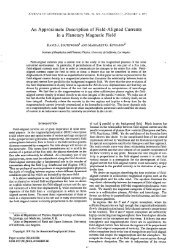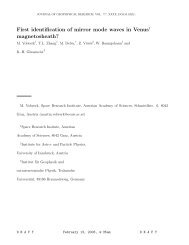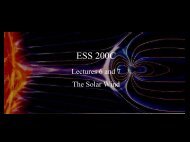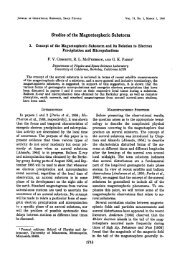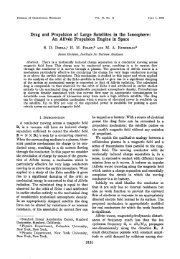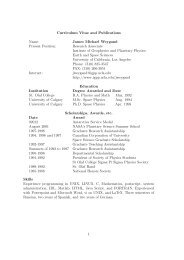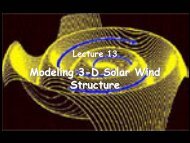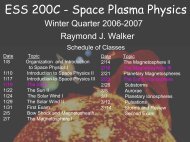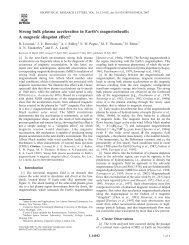Outer magnetospheric structure: Jupiter and Saturn compared
Outer magnetospheric structure: Jupiter and Saturn compared
Outer magnetospheric structure: Jupiter and Saturn compared
You also want an ePaper? Increase the reach of your titles
YUMPU automatically turns print PDFs into web optimized ePapers that Google loves.
A04224<br />
WENT ET AL.: OUTER MAGNETOSPHERIC STRUCTURE<br />
A04224<br />
Figure 6. The critical ion density, N C , required for magnetodisk breakdown in the (top) Jovian <strong>and</strong> (bottom)<br />
<strong>Saturn</strong>ian magnetospheres is shown in red. The measured thermal electron density is shown in blue,<br />
<strong>and</strong> the 1 s variability in the mean location of the Joy et al. [2002] (<strong>Jupiter</strong>) <strong>and</strong> Arridge et al. [2006] (<strong>Saturn</strong>)<br />
magnetopause is shaded in grey, mapped to the local time of the magnetopause crossing. Vertical black lines<br />
denote the actual location of the magnetopause observed by each spacecraft.<br />
configuration reminiscent of the cushion region. Small<br />
clumps of plasma containing closed loops of magnetic<br />
field may detach from the outer edge of the magnetodisk<br />
but, for the most part, this plasma will remain inside the<br />
magnetopause <strong>and</strong> eventually diffuse onto adjacent <strong>magnetospheric</strong><br />
field lines. Eventually, this plasma will be lost in<br />
the magnetotail.<br />
[43] Can this effect explain the formation of the cushion<br />
region at <strong>Jupiter</strong> <strong>and</strong>, similarly, the absence of a cushion<br />
region at <strong>Saturn</strong>? The radial distance at which the magnetodisk<br />
breaks down can be estimated from the <strong>magnetospheric</strong><br />
force balance condition (equation (1)) if we make the simplifying<br />
assumptions that m i m e <strong>and</strong> that the poorly constrained<br />
outward acting pressure gradient forces are equal<br />
to some multiple, k, of the centrifugal force.<br />
[44] Rearranging equation (1) for the field line radius of<br />
curvature, R C , under these assumptions we obtain<br />
B 2<br />
R C <br />
ðk þ 1Þ 0 N i m i W 2 ; ð5Þ<br />
from which it is immediately apparent that, for increasing<br />
outward forces, the field line radius of curvature will<br />
decrease. This decrease cannot continue indefinitely, however,<br />
as the radius of curvature will eventually approach<br />
values comparable with the ion gyroradius. At this point<br />
the MHD assumptions upon which equation (1) is based will<br />
begin to break down <strong>and</strong>, for a low‐energy plasma, the<br />
magnetic field is likely to develop an x line. Reconnection at<br />
this x line may explain many of the magnetic nulls observed<br />
in the transition region at <strong>Jupiter</strong> by Haynes [1995].<br />
[45] Assuming that ions have a kinetic energy E KE ∼ (3/2)<br />
k B T i , where T i is the mean ion temperature, the mean ion<br />
gyroradius, R g , for equatorially mirroring particles may be<br />
expressed as<br />
R g ¼ m <br />
i 2k B T 1=2<br />
i<br />
; ð6Þ<br />
jq i jB m i<br />
where q i is the mean electromagnetic charge on an ion.<br />
Setting R C = R g in equation (5), substituting for equation (6)<br />
<strong>and</strong> rearranging for N i gives<br />
jq i jB 3 <br />
m 1=2<br />
i<br />
N C <br />
; ð7Þ<br />
ðk þ 1Þ 0 m 2 i W2 2k B T i<br />
where N C is now the critical number density required for<br />
the ion gyroradius <strong>and</strong> field line radius of curvature to be<br />
equal. To estimate the distance at which this critical density<br />
is reached in each magnetosphere the value of N C must be<br />
<strong>compared</strong> with the observed number density measured by in<br />
situ spacecraft. This comparison is presented in Figure 6 for<br />
the Ulysses (inbound) pass at <strong>Jupiter</strong> <strong>and</strong> Cassini Rev 20<br />
(inbound) pass at <strong>Saturn</strong> where it has been assumed that ion<br />
<strong>and</strong> electron number densities <strong>and</strong> temperatures are equal.<br />
This assumption is qualitatively consistent with the results<br />
of Thomsen et al. [2010].<br />
11 of 14



